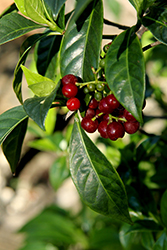Fri & Sat 8am - 8pm
Sun 8am - 7pm
Anytown, USA 12345
fax: 261.787.0463
e-mail: info@successgc.com


Plant Finder

Height: 4 feet
Spread: 4 feet
Sunlight:
![]()
![]()
Hardiness Zone: 10b
Description:
An evergreen shrub featuring small, ridged foliage that is very glossy; flower clusters appear year round, except when there is cold or drought, followed by showy berries; prefers sunnier locations than related wild coffees; a good landscape specimen
Ornamental Features
Bahama Wild Coffee is primarily grown for its highly ornamental fruit. It features an abundance of magnificent crimson berries from early winter to late fall. The fruit can be messy if allowed to drop on the lawn or walkways, and may require occasional clean-up. Its attractive small glossy narrow leaves remain dark green in color with curious grayish green undersides throughout the year. It features subtle clusters of white flowers at the ends of the branches from early winter to late fall, which emerge from distinctive chartreuse flower buds. The tan stems can be quite attractive.
Landscape Attributes
Bahama Wild Coffee is a multi-stemmed evergreen perennial with a more or less rounded form. Its medium texture blends into the garden, but can always be balanced by a couple of finer or coarser plants for an effective composition.
This plant will require occasional maintenance and upkeep, and can be pruned at anytime. It is a good choice for attracting birds, bees and butterflies to your yard. It has no significant negative characteristics.
Bahama Wild Coffee is recommended for the following landscape applications;
- Mass Planting
- Hedges/Screening
- General Garden Use
- Naturalizing And Woodland Gardens
- Container Planting
Planting & Growing
Bahama Wild Coffee will grow to be about 4 feet tall at maturity, with a spread of 4 feet. Although it is technically a woody plant, this plant can be expected to behave as a perennial in our climate if planted outdoors over the winter, usually regrowing from its base (crown) the following year. As such, gardeners should take into consideration that it will perform differently than it would in its native habitat. This is a self-pollinating variety, so it doesn't require a second plant nearby to set fruit.
This plant does best in full sun to partial shade. It is very adaptable to both dry and moist growing conditions, but will not tolerate any standing water. It is considered to be drought-tolerant, and thus makes an ideal choice for a low-water garden or xeriscape application. This plant should not require much in the way of fertilizing once established, although it may appreciate a shot of general-purpose fertilizer from time to time early in the growing season. It is not particular as to soil type or pH, and is able to handle environmental salt. It is somewhat tolerant of urban pollution. This species is native to parts of North America.
Bahama Wild Coffee is a fine choice for the garden, but it is also a good selection for planting in outdoor pots and containers. Because of its height, it is often used as a 'thriller' in the 'spiller-thriller-filler' container combination; plant it near the center of the pot, surrounded by smaller plants and those that spill over the edges. It is even sizeable enough that it can be grown alone in a suitable container. Note that when growing plants in outdoor containers and baskets, they may require more frequent waterings than they would in the yard or garden.
